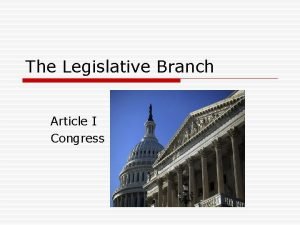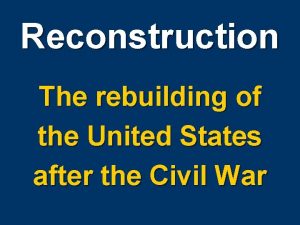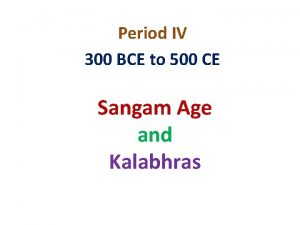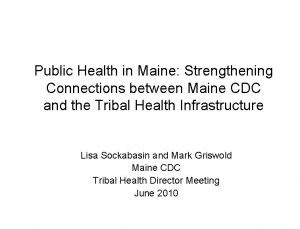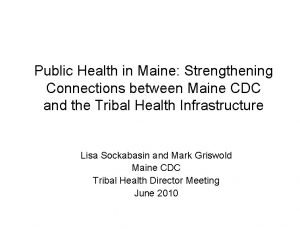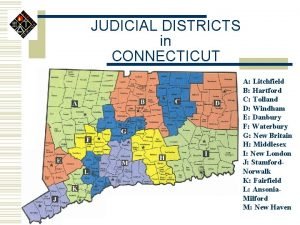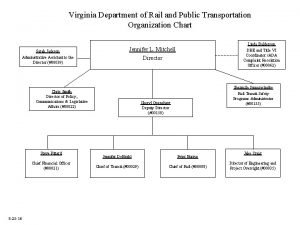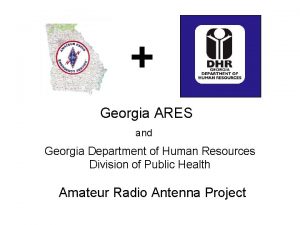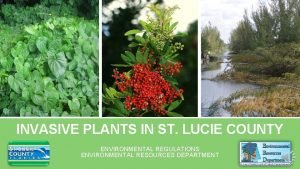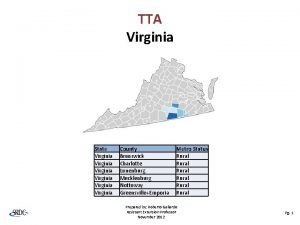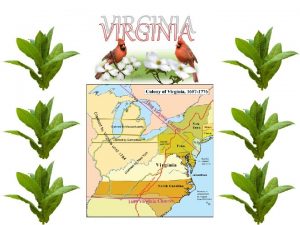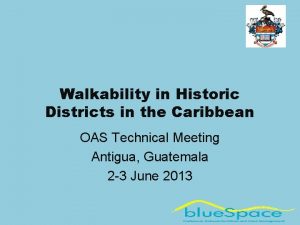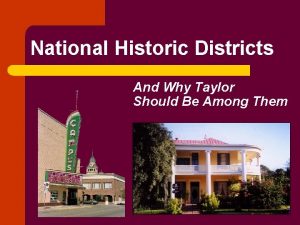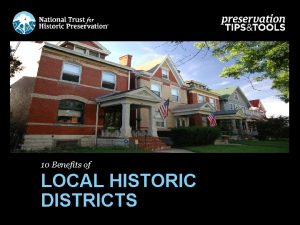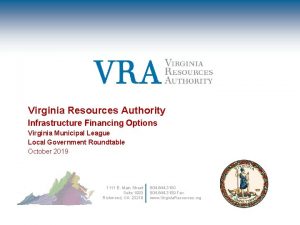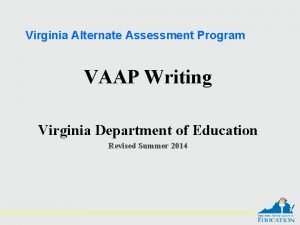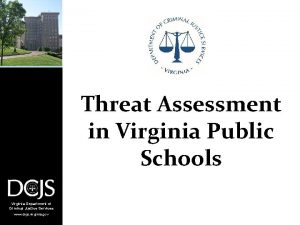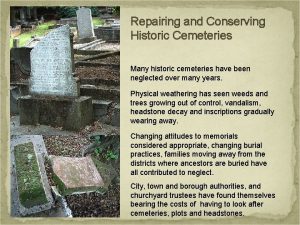Historic Districts in Virginia Department of Historic Resources
































- Slides: 32

Historic Districts in Virginia Department of Historic Resources Richmond, Virginia June 2014

Basics of Historic Districts • What are historic districts and how did they come into being? • What are the different levels of historic district designation and what are their consequences and benefits?

What is a Historic District? • Significant concentration or linkage of resources • A place important for many reasons— Architecture, History, People, Archaeology, etc. • The whole captures the feel of an era or the evolution of many eras

Local, State, and National Historic District Designations Four Types of Historic Districts • Locally Designated • National Historic Landmarks • National Register of Historic Places • Virginia Landmarks Register

Legal Basis for Local, State, and National Historic District Designations • Local Historic Districts - adopted pursuant to § 15. 2 -2306 of the Code of Virginia • Virginia Landmarks Register - procedure established in § 10. 1 -2206 of the Code of Virginia • National Historic Landmarks - Historic Sites Act of 1935 - Code of Federal Regulations - 36 CFR 65. 5 • National Register of Historic Places - National Historic Preservation Act of 1966, as amended - Code of Federal Regulations - 36 CFR 60

How to Find State and Federal Regulations • A searchable database of the Code of Virginia is online at http: //leg 1. state. va. us/000/src. htm • A searchable database of the Administrative Code of Virginia is online at http: //leg 1. state. va. us/cgibin/legp 504. exe? 000+men+SRR • The full text and searchable version of federal regulations for the National Historic Landmarks and National Register programs is online at http: //www. ecfr. gov/cgi-bin/textidx? c=ecfr&rgn=div 5&view=text&node=36: 1. 0. 1. 1. 26&id no=36 and at http: //www. cr. nps. gov/nr/regulations. htm

Thumbnail History of Historic Districts Local Districts: Charleston 1931 New Orleans French Quarter 1937 Old and Historic Alexandria 1946 St. John’s Church Old and Historic District 1957 National Historic Landmark Districts: Williamsburg Historic District 1960 National and State Register Districts: More than 450 in Virginia and counting!

Local Historic Districts: Authority in Code of Virginia In Virginia, local historic district ordinances are adopted pursuant to § 15. 2 -2306 of the Code of Virginia. n This is “enabling legislation” that provides a framework for a local government to pass an ordinance. Local governments are not required to adopt historic district ordinances if they do not wish to designate such districts. n Ordinances should consider a community’s unique resources and character. n

Uses of Local District Designation n n n Tool for managing change while maintaining the character of a district through use of planning, zoning, and permitting processes. Recognizes the value of existing places and helps to preserve a sense of place. Encourages re-investment and redevelopment of older building stock; also can help to curb sprawl development. Protects property owner and local government investments in property maintenance and infrastructure. Helps to encourage better design through design guidelines and/or architectural review. Connects residents and visitors to an area’s history and architecture. Can be linked to plaques, signage and local tax abatements programs.

Essentials of the NHL Program Requirements for NHL designation are similar to those for the National Register of Historic Places, with a few key differences: • A property owner seeking NHL designation works directly with NHL program staff. • NHL staff assist the property owner with preparing a nomination that details the property’s significance and integrity. • Experts from across the nation review the NHL nomination. • The Landmarks Committee reviews the NHL nomination and makes a recommendation to the National Park System Advisory Board. • The National Park System Advisory Board reviews and makes a recommendation to the Secretary of the Interior. • The Secretary of the Interior considers the recommendations and determines if the property will be designated an NHL. • Further information is available at http: //www. nps. gov/nhl/learn/intro. htm.

Protection of NHLs NHL designation is honorary, but can help to recognize, preserve, and protect important locations in American history. • NHLs may have additional protections from development (depending on local preservation laws). • NHLs may be eligible for preservation grants from a variety of sources. • NHLs are eligible for federal tax incentives and, in Virginia, are eligible for easements and state tax incentives. • The National Park Service offers extensive technical assistance to owners of NHLs. • Further information is available at http: //www. nps. gov/nhl/learn/benefits. htm, or contact DHR staff.

National Historic Landmark Historic Districts in Virginia As of June 2014, Virginia has 122 NHLs, of which 13 are designated as historic districts: Alexandria HD; Bremo HD; Fort Myer HD; Green Springs HD; Jackson Ward HD; Monument Avenue HD; Potomac Canal HD; Thunderbird Archaeological District; University of Virginia HD; Virginia Military Institute HD; Washington and Lee University HD; Waterford HD; and Williamsburg HD. Virginia also has 10 battlefields that are NHLs; battlefields are generally understood to be a type of historic district as they typically encompass large acreage with a variety of resources.

National Register and VLR Historic Districts The Virginia Landmarks Register mirrors the National Register of Historic Places. Both programs use the same Criteria for evaluation, nomination form, and review and approval processes. Both types of historic districts are strictly honorary: • No imposition of design guidelines or architectural design review processes. • No restrictions on use of property • No requirements to maintain, rehabilitate, or restore a historic property to a particular standard. • No change in property taxes or value • No automatic protection from development, demolition or other potential threats.

What National Register and VLR Designation Does • Officially recognizes the historic significance of a site or area • Encourages but does not require preservation • Requires a review process to identify historic properties that may be harmed by harmful federally funded, licensed, and permitted activities • May qualify owners for state and federal rehabilitation tax credits and for easement donations

National Register and VLR Thresholds 1. Property typically must have achieved significance within the last 50 years, or be of exceptional importance 2. Property must meet one of the Register Criteria 3. Property must retain physical integrity

Criteria for National Register and VLR Listing • Criterion A - Associated with events that have made a significant contribution to broad patterns of our history; • Criterion B - Associated with the lives of persons significant in our past; • Criterion C - Represent distinctive architectural style, period or method of construction; or the work of a master; or represent a significant and distinguishable entity with many components (historic districts); or • Criterion D - Likely to yield information important in prehistory and history

Evaluating Integrity is the ability of a property to convey its significance • Before you can evaluate the integrity of a property you have to know why, where, and when a property is significant. • Next, define the essential physical features that must be present for a property to represent its significance. • Finally, determine which aspects of integrity are most essential to the property being eligible for the National Register and VLR.

Physical Integrity Properties must retain the ability to communicate their significance through some combination of the seven aspects of integrity: • Location • Design • Setting • Materials • Workmanship • Feeling • Association

What Can be Nominated as a Historic District? An entity that is “a significant concentration, linkage, or continuity of sites, buildings, structure, or objects united historically or aesthetically by plan or physical development” can be nominated to the National Register and VLR. For example, districts can range from rural to urban settings: Goose Creek Rural HD, Loudoun County Broad Street Commercial HD, Richmond

In Rural Historic Districts… • Landscape is of primary importance. • Acreage is usually much larger than urban districts. • Influence of the natural environment is visible. • Number of man-made structures is relatively low by comparison. • Common types: Agricultural, Maritime, Recreational, Military (battlefields).

In Urban/Suburban Historic Districts… • Resources may be more densely packed. • Open land area is reduced, so total acreage can be small (but not necessarily). • Natural environment may or may not be important. • Man-made resources will usually dominate. • Common types: Residential, Commercial, Industrial, Government, Educational

National Register and VLR Historic District Variety Even among districts of the same general type, such as residential, great variety can be found. Hollin Hills HD, Fairfax County Pierce Street HD, Lynchburg Riverland HD, Roanoke Parkfairfax,

What Resources Make Up a Historic District? Resources within historic districts may consist of buildings, sites, structures, and/or objects. Resources are either contributing or noncontributing to the historic district. Streets, landscaping, vegetation, paths, walkways, piers, open spaces, vacant lots, and other features are generally considered part of the district’s setting.

What does “Contributing” mean? A resource contributes to the historic character of the district because: • It was present during the time when the district gained its significance (period of significance) • It relates to the significant historic themes of the district • It retains historic integrity from the period of significance (physically still appears as a historic building)

What does “Non-contributing” mean? The resource does not add to the historic character of the district because: • It was built outside the district’s period of significance (after or before). • It does not relate to the historic theme(s) of the district. • Due to alterations, changes, or additions, it no longer retains historic integrity (no longer conveys its historic associations).

How are Historic District Boundaries Chosen? Historic district boundaries may be based on one or a combination of factors, the most typical including: • Physical, natural boundaries: rivers, lakes, hills, valleys, etc. • Man-made features: roads, highways, etc. • Political boundaries: corporation lines, wards, etc. • Age of buildings. • Architectural style. • Associations with historical events or persons. • Integrity—how much has been lost to demolition or incompatible development? • Cultural relationships (particularly archaeological districts).

What is DHR’s role in Nominating National Register and VLR Historic Districts? • Residents/locality works with DHR to achieve designation and technical assistance afterward. • DHR reviews and processes nomination, and notifies all owners and adjacent owners of the nomination. • Board of Historic Resources reviews nomination and places it in the VLR; State Review Board reviews nomination and recommends it to be sent to the National Park Service to inclusion in the NRHP.

What Can You Do with a National Register/VLR Historic District? • Economic Opportunities: tax credits, easements • Heritage Tourism: area pamphlet, walking tour, interpretive trails, website, business owners’ associations, Main Street program, etc. • Smart Growth/Community Identity: local incentives/assistance, local preservation districts, technical assistance available from DHR, encourages responsible growth decisions

What is the Impact of a Historic District Designation on Property Values? Local property values can be influenced by numerous factors, ranging from employment rates and economic activity to consequences of natural disasters. Historic district designation has not been found to influence property values in either a positive or negative way. A 1992 General Assembly study found that historic designation had no discernible pattern of negative effect on property value • Property assessments usually follow the market; not dictate to it • Values within historic districts rose in general accord with other properties • Any effect of a district designation is usually indirect and partial: historic district properties are often maintained better by concerned owners, therefore property values may go up,

Will National Register/VLR Listing Automatically Lead to a Local Historic District Designation? National Register/VLR historic districts are designated under a different process for local historic districts. One does not necessarily lead to the other. • Nearly 500 VLR/NR districts have been listed in Virginia. • 70 -80 local districts have been designated. • Different criteria are used for designating local districts. • Though they can coincide, there is no requirement that local and VLR/NRHP district boundaries match exactly.

National Park Service Bulletins The National Park Service has published numerous bulletins to assist researchers and writers with preparing nominations. Following are those most likely to aid with nominating a historic district. • How to Apply the National Register Criteria for Evaluation • How to Complete the National Register Registration Form • Historic Residential Suburbs: Guidelines for Evaluation and Documentation for the National Register of Historic Places • Guidelines for Evaluating and Registering Archaeological Properties • Guidelines for Identifying, Evaluating, and Registering America’s Historic Battlefields • How to Evaluate and Nominate Designed Historic Landscapes • Guidelines for Evaluating and Documenting Rural Historic Landscapes The full text of these bulletins is available online at

Additional Sources of Information DHR – Central and Regional Offices: www. dhr. virginia. gov National Park Service, National Register of Historic Places: http: //www. nps. gov/history/nr/
 Virginia department of historical resources
Virginia department of historical resources Northern virginia seo
Northern virginia seo Iowa state patrol districts
Iowa state patrol districts Number of representatives per state
Number of representatives per state Colorado springs school districts
Colorado springs school districts What are the districts in paris called
What are the districts in paris called Maharashtra district in 1960
Maharashtra district in 1960 Category 5 and 6 local authority districts
Category 5 and 6 local authority districts Carpetbaggers cartoon
Carpetbaggers cartoon Russia federal districts
Russia federal districts East odisha districts
East odisha districts Srilankan tamil
Srilankan tamil Dbedashboard
Dbedashboard Maine public health districts
Maine public health districts What is the punishment for eating crops in district 11?
What is the punishment for eating crops in district 11? Majority-minority districts definition ap human geography
Majority-minority districts definition ap human geography Philippine association of water districts
Philippine association of water districts Texas recapture districts
Texas recapture districts Voting districts definition ap human geography
Voting districts definition ap human geography Texas recapture districts
Texas recapture districts Maine public health districts
Maine public health districts Zoning districts
Zoning districts Connecticut judicial districts
Connecticut judicial districts Texas recapture districts
Texas recapture districts Virginia department for the blind and vision impaired
Virginia department for the blind and vision impaired Virginia department of agriculture food safety
Virginia department of agriculture food safety Virginia department of rail and public transportation
Virginia department of rail and public transportation Transformed and transforming resources
Transformed and transforming resources Differentiate fixed resources and variable resources
Differentiate fixed resources and variable resources Renewable vs nonrenewable resources worksheet
Renewable vs nonrenewable resources worksheet Oregon water resources department
Oregon water resources department Ga dhr
Ga dhr St lucie county environmental resources department
St lucie county environmental resources department



